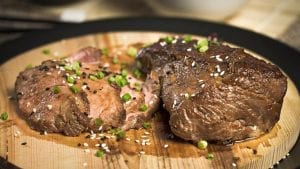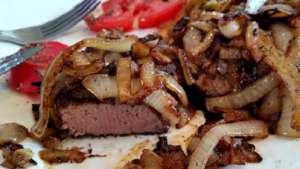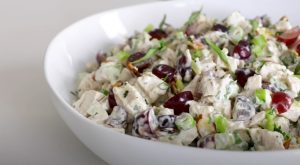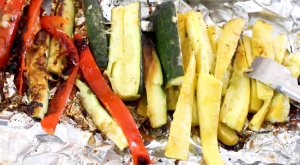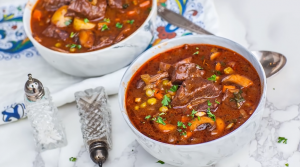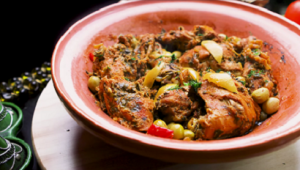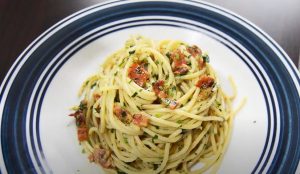The perfect balance of savory and sweet makes this Stuffed Pork Tenderloin with Apples and Dried Fruit a crowd favorite. The buttery roasted apples and rich, warm flavors of the dried fruit create a delectable stuffing, while the pork tenderloin, seasoned and seared to perfection, serves as the ideal canvas for these flavors.
Photos of Pork Tenderloin Stuffed with Apples and Dried Fruit Recipe
This recipe calls for dried mixed fruit, a product usually found in the baking aisle of your local supermarket. It typically contains a blend of raisins, cranberries, and apricots, but can vary based on the brand. Granny Smith apples are chosen for their tartness, which contrasts nicely with the rich flavors of the pork and dried fruit. A full-bodied dry red wine, like a Cabernet Sauvignon or a Shiraz, is recommended to bring out the deep flavors in this dish.
Ingredients For Pork Tenderloin Stuffed With Apples And Dried Fruit
Mixed dried fruit: These are often a blend of dried raisins, cranberries, apricots, prunes, and sometimes tropical fruits. They provide a chewy texture and sweet flavor.
Dry red wine: This is used to rehydrate the dried fruit and provide a rich, deep flavor.
Unsalted butter: It is used to sauté the onion and apple, and helps in browning the pork.
Granny Smith apple: Known for its tart flavor and firm texture, it balances the sweetness of the dish.
Onion: This adds a savory base note to the stuffing.
Water: It's used to deglaze the pan and help the onion cook.
Salt and Pepper: Basic seasonings to enhance the flavors.
Pork Tenderloin: An ideal cut of meat for stuffing and roasting, it's tender and lean.
Vegetable oil: This is used to sear the pork and help it develop a crispy crust.
Chicken stock: It's used to create a flavorful sauce.
One reader, Gustav Libby says:





This pork tenderloin stuffed with apples and dried fruit recipe is a game-changer! The combination of tender pork, sweet apples, and tangy dried fruit creates a burst of flavors in every bite. It's a delightful dish that's perfect for special occasions or a cozy family dinner. Highly recommended!
Techniques Required
How to prepare the dried fruit: Soak the mixed dried fruit in the full-bodied dry red wine in a small bowl, allowing the fruit to absorb the wine and plump up.
How to cook the apple and onion mixture: In a large ovenproof skillet, melt the butter and add the sliced granny smith apple. Cook over moderate heat for 3 minutes, then add the onion and cook, stirring occasionally, until softened, about 7 minutes.
How to stuff the pork tenderloin: Insert a sharpening steel or the handle of a wooden spoon into the thick end of the tenderloin. Carefully push the steel through the tenderloin and roll the meat to widen the hole slightly. Stuff the tenderloin with the fruit mixture and seal the ends with toothpicks.
How to brown the pork tenderloin: Heat the oil in the skillet and season the meat with salt and pepper. Brown the tenderloin in the skillet over high heat, turning, for about 6 minutes.
How to make the sauce: After roasting the meat, add the reserved wine to the skillet and cook over high heat, scraping up any browned bits, until syrupy, about 2 minutes. Then, add the chicken stock and cook until reduced by half, about 5 minutes. Finally, stir in the reserved 1/2 cup of the fruit mixture and season with salt and pepper.
How To Make Pork Tenderloin Stuffed with Apples and Dried Fruit
Indulge yourself with a succulent plate of this pork tenderloin! It’s deliciously stuffed with a medley of fruits and served with a rich wine sauce.
Serves:
Ingredients
- ½cupmixed dried fruit,coarsely chopped
- ¼cupfull bodied dry red wine
- 1tspunsalted butter
- 1granny smith apple
- ¼cuponion,finely chopped
- 3tbspwater
- salt and freshly ground pepper
- 1lbpork tenderloin
- 1tspvegetable oil
- ½cupchicken stock,or canned low sodium broth
Instructions
-
In a small bowl, mix the dried fruit with the wine.
-
Melt the butter in a large ovenproof skillet. Add the apple and cook over moderate heat for 3 minutes.
-
Add the onion and cook, stirring, for about 7 minutes until softened. Add the water as the pan dries out.
-
Drain the dried fruit, reserving the wine.
-
Stir the dried fruit into the apple and onion in the skillet and season with salt and pepper. Transfer to a plate to cool.
-
Coarsely chop ½ cup of the fruit mixture and reserve it for making the sauce. Wipe out the skillet.
-
Preheat the oven to 425 degrees F.
-
Insert a sharpening steel or the handle of a wooden spoon into the thick end of the tenderloin. Carefully push the steel through the tenderloin and roll the meat to widen the hole slightly.
-
Stuff the tenderloin with the fruit mixture and seal the ends with toothpicks.
-
Heat the oil in the skillet. Season the meat with salt and pepper and brown it in the skillet over high heat, turning, for about 6 minutes.
-
Transfer the skillet to the oven and roast the meat for 10 minutes.
-
Transfer the meat to a cutting board and let rest for 5 minutes.
-
Add the reserved wine to the skillet and cook over high heat, scraping up any browned bits, for about 2 minutes, until syrupy. Add the stock and cook for about 5 minutes until reduced by half.
-
Stir in the reserved ½ cup of the fruit mixture and season with salt and pepper.
-
Slice the tenderloin crosswise ½-inch thick.
-
Serve with sauce, and enjoy!
Nutrition
- Calories: 257.13kcal
- Fat: 6.76g
- Saturated Fat: 2.15g
- Trans Fat: 0.09g
- Monounsaturated Fat: 2.86g
- Polyunsaturated Fat: 1.02g
- Carbohydrates: 21.05g
- Fiber: 3.22g
- Sugar: 13.53g
- Protein: 25.29g
- Cholesterol: 77.15mg
- Sodium: 571.89mg
- Calcium: 23.13mg
- Potassium: 772.16mg
- Iron: 2.20mg
- Vitamin A: 32.37µg
- Vitamin C: 1.76mg
Technique Tip for Making Pork Tenderloin Stuffed With Apples and Dried Fruit
When stuffing the pork tenderloin, it's important to ensure the hole is wide enough to accommodate the fruit mixture but not so large that the stuffing falls out during cooking. Using a sharpening steel or the handle of a wooden spoon can help achieve the right size. Additionally, sealing the ends with toothpicks helps to keep the stuffing inside the meat while it cooks. Remember to remove the toothpicks before serving.
Time-Saving Tips for Making This Stuffed Pork Tenderloin Recipe
Prepare the filling: To save time, prepare the filling for the pork tenderloin in advance. You can chop the dried fruit, apple, and onion ahead of time and store them in the refrigerator until you're ready to stuff the tenderloin.
Use pre-cut dried fruit: Consider using pre-cut dried fruit to save time on chopping and preparation. This can be a convenient option for busy cooks and can help streamline the recipe process.
Multitask: While the pork tenderloin is roasting in the oven, use that time to prepare the sauce. This allows you to maximize efficiency and get the most out of your cooking time.
Invest in a good quality tenderloin: Choosing a high-quality pork tenderloin can reduce cooking time and ensure a tender and flavorful result. Look for a well-trimmed tenderloin to minimize prep work.
Organize your ingredients: Before you start cooking, organize all your ingredients and tools to create an efficient cooking process. This can help save time and minimize any last-minute scrambling for items.
Substitute Ingredients For Pork Tenderloin Stuffed with Apples and Dried Fruit Recipe
mixed dried fruit - Substitute with dried cranberries: Dried cranberries can provide a similar sweet and tart flavor profile as mixed dried fruit, and they will add a burst of color and texture to the dish.
full bodied dry red wine - Substitute with beef broth: Beef broth can add depth of flavor and richness to the dish, similar to red wine, and it will complement the pork and fruit stuffing.
unsalted butter - Substitute with olive oil: Olive oil can be used as a heart-healthy alternative to butter, providing a similar richness and flavor when sautéing the ingredients.
granny smith apple - Substitute with honeycrisp apple: Honeycrisp apples have a sweet-tart flavor and firm texture, making them a suitable substitute for granny smith apples in the stuffing.
onion - Substitute with shallot: Shallots have a milder, sweeter flavor compared to onions, and they can add a subtle depth of flavor to the stuffing mixture.
pork tenderloin - Substitute with chicken breast: Chicken breast can be stuffed and prepared in a similar manner to pork tenderloin, and it will work well with the fruit and apple stuffing.
vegetable oil - Substitute with canola oil: Canola oil is a neutral-flavored oil that can be used as a substitute for vegetable oil in cooking and sautéing.
chicken stock - Substitute with vegetable stock: Vegetable stock can provide a flavorful base for the sauce, and it will complement the fruit and apple flavors in the dish.
Presenting Pork Tenderloin Stuffed With Apples and Dried Fruit
- Elevate the plating: As a chef, presentation is key. Arrange the sliced pork tenderloin on the plate in a visually appealing manner, ensuring that the stuffing is visible and the colors are vibrant.
- Garnish with fresh herbs: Sprinkle the dish with finely chopped parsley or thyme to add a pop of color and a hint of freshness to the plate.
- Create a sauce swirl: Use a small spoon to carefully drizzle the fruit-infused sauce in a circular motion around the pork, creating an elegant and artistic swirl on the plate.
- Incorporate edible flowers: Introduce a touch of sophistication by delicately placing edible flowers, such as nasturtiums or pansies, around the dish for a visually stunning presentation.
- Utilize negative space: Allow the plate to breathe by strategically leaving some areas empty, creating a balanced and visually appealing composition.
Essential Tools for Making Stuffed Pork Tenderloin
- Ovenproof skillet: A skillet that can be used both on the stovetop and in the oven, typically made of materials such as cast iron or stainless steel.
- Small bowl: A small container used for mixing or holding small amounts of ingredients.
- Skewer or sharpening steel: A long, pointed metal rod used for piercing and creating a cavity in the pork tenderloin for stuffing.
- Cutting board: A flat board used for cutting and preparing ingredients.
- Wooden spoon: A spoon made of wood, often used for stirring and mixing ingredients.
- Toothpicks: Small, pointed sticks used for securing the stuffed pork tenderloin.
- Food processor: A kitchen appliance used for chopping, blending, and pureeing ingredients.
- Mixing bowl: A bowl used for combining ingredients.
- Knife: A sharp tool used for cutting and slicing ingredients.
- Measuring cups and spoons: Tools used for accurately measuring ingredients in cooking and baking.
- Whisk: A utensil used for mixing and blending ingredients together.
- Tongs: A tool with two arms and a pivot used for gripping and lifting items, such as turning the pork tenderloin while browning.
How To Store and Freeze Stuffed Pork Tenderloin
Allow the pork tenderloin to cool completely before storing or freezing. This will prevent condensation from forming and causing soggy or freezer-burned meat.
Wrap the cooled pork tenderloin tightly in plastic wrap, making sure to remove as much air as possible. Then, wrap it in a layer of aluminum foil for extra protection.
Label the wrapped pork tenderloin with the date and contents using a permanent marker.
To store in the refrigerator:
- Place the wrapped pork tenderloin in the coldest part of the refrigerator, typically the back of the bottom shelf.
- Properly stored, the pork tenderloin will keep for 3-4 days in the refrigerator.
To freeze:
- Place the wrapped pork tenderloin in a freezer-safe container or freezer bag, removing as much air as possible if using a bag.
- Properly frozen, the pork tenderloin will keep for up to 2-3 months in the freezer.
To reheat:
- Thaw the frozen pork tenderloin in the refrigerator overnight.
- Remove the plastic wrap and aluminum foil, and place the pork tenderloin in a baking dish.
- Cover the dish with foil and reheat in a preheated 325°F (165°C) oven for about 20-25 minutes, or until the internal temperature reaches 165°F (74°C).
- Alternatively, you can reheat individual slices in the microwave or in a skillet over medium heat until warmed through.
To maintain the best quality and flavor, consume the reheated pork tenderloin within 1-2 days of thawing.
How To Reheat Leftovers
Preheat your oven to 350°F (175°C). Place the leftover pork tenderloin on a baking sheet and cover it loosely with aluminum foil. Bake for about 15-20 minutes, or until the internal temperature reaches 145°F (63°C). This method helps to retain the moisture and prevent the meat from drying out.
Slice the leftover pork tenderloin into 1/2-inch thick pieces. Heat a tablespoon of olive oil or butter in a skillet over medium heat. Add the sliced pork and cook for 2-3 minutes on each side, or until heated through. This method is quick and helps to create a slightly crispy exterior.
If you have a sous vide machine, you can reheat the leftover pork tenderloin using this precise cooking technique. Place the pork in a vacuum-sealed bag or a ziplock bag with the air removed. Set the sous vide machine to 140°F (60°C) and cook the pork for about 45 minutes, or until it reaches the desired temperature. This method ensures even heating and maintains the original texture of the meat.
For a quick and easy reheating method, use your microwave. Slice the leftover pork tenderloin and place the pieces in a microwave-safe dish. Cover the dish with a damp paper towel to prevent the meat from drying out. Microwave on high for 1-2 minutes, or until the pork is heated through. Be careful not to overheat, as this can cause the meat to become tough.
If you want to add some extra flavor to your leftover pork tenderloin, try slicing it and incorporating it into a stir-fry or fried rice dish. The high heat from the stir-frying process will quickly reheat the pork while allowing it to absorb the flavors of the other ingredients, such as vegetables, soy sauce, and spices.
Random Fact About Pork Tenderloin Stuffed With Apples and Dried Fruit
Pork tenderloin stuffed with apples and dried fruit is a delicious and healthy dish that provides a good source of protein and essential nutrients. Pork tenderloin is a lean cut of meat, making it a great option for those looking to reduce their fat intake. Apples and dried fruit add a natural sweetness and a burst of flavor to the dish, making it a delightful combination of savory and sweet. This dish is also versatile and can be served with a variety of side dishes, making it a perfect choice for a family meal or special occasion.
Is This Stuffed Pork Tenderloin Recipe Economical for Home Cooking?
This pork tenderloin stuffed with apples and dried fruit recipe offers a delightful blend of flavors and textures. The cost-effectiveness is moderate due to the use of pork tenderloin and dried fruits, which can be pricier ingredients. However, the dish's impressive presentation and rich taste make it a worthy investment for special occasions. On a scale of 1-10, this recipe earns an 8 for its taste and visual appeal. The approximate cost for a household of 4 people is around $25-$30, making it a reasonable choice for a memorable family dinner.
Is This Stuffed Pork Tenderloin Recipe Healthy or Unhealthy?
The pork tenderloin stuffed with apples and dried fruit recipe is a relatively healthy dish with some room for improvement. Here's why:
Positives:
- Pork tenderloin is a lean protein source, providing essential amino acids without excessive saturated fat
- Apples and dried fruits offer dietary fiber, vitamins, and minerals
- The recipe uses minimal added fat (butter and oil) and relies on healthier cooking methods like roasting
Negatives:
- The dried fruit, while nutritious, can be high in sugar and calories
- The recipe calls for red wine, which adds alcohol and extra calories
- The sodium content may be elevated depending on the amount of salt used
To make this recipe even healthier, consider the following suggestions:
- Reduce the amount of dried fruit or choose varieties with lower sugar content, such as prunes or apricots
- Replace the red wine with an equal amount of low-sodium chicken or vegetable stock to maintain moisture without adding alcohol or extra calories
- Use herbs and spices to enhance flavor while minimizing the need for added salt
- Serve the pork tenderloin with a side of steamed or roasted vegetables to increase the overall nutrient density of the meal
- Opt for whole grain or fiber-rich sides, such as quinoa or brown rice, to complement the dish and provide additional health benefits
By making these adjustments, you can elevate the nutritional value of this already tasty and satisfying meal, ensuring that it aligns with your health goals while still delivering on flavor and texture.
Editor's Thoughts on This Stuffed Pork Tenderloin Recipe
This pork tenderloin stuffed with apples and dried fruit recipe is a delightful combination of savory and sweet flavors. The use of dried fruit and red wine adds a rich and complex taste to the dish, while the tenderloin remains juicy and flavorful. The cooking method ensures a perfectly cooked and succulent pork tenderloin. The sauce made from the pan drippings, wine, and fruit mixture adds a luscious finishing touch. Overall, this recipe offers a wonderful balance of textures and flavors, making it a delightful choice for a special dinner.
Enhance Your Pork Tenderloin Stuffed with Apples and Dried Fruit Recipe with These Unique Side Dishes:
Alternative Recipes Similar to This Stuffed Pork Tenderloin
Suggested Appetizers and Desserts to Serve With This Stuffed Pork Tenderloin Recipe
Why trust this Pork Tenderloin Stuffed with Apples and Dried Fruit Recipe:
This recipe offers a delightful combination of flavors and textures, featuring a succulent pork tenderloin stuffed with a sweet and tangy mixture of apples, dried fruit, and a splash of full-bodied red wine. The careful preparation and cooking process ensure a tender and juicy result, while the accompanying sauce, made with the reserved wine and chicken stock, adds a rich and savory finish. With the use of quality ingredients such as Granny Smith apple and mixed dried fruit, this recipe promises a delightful dining experience, making it a trustworthy choice for a memorable meal.
Was this page helpful?
Have your own special recipe to share? Submit Your Recipe Today!

